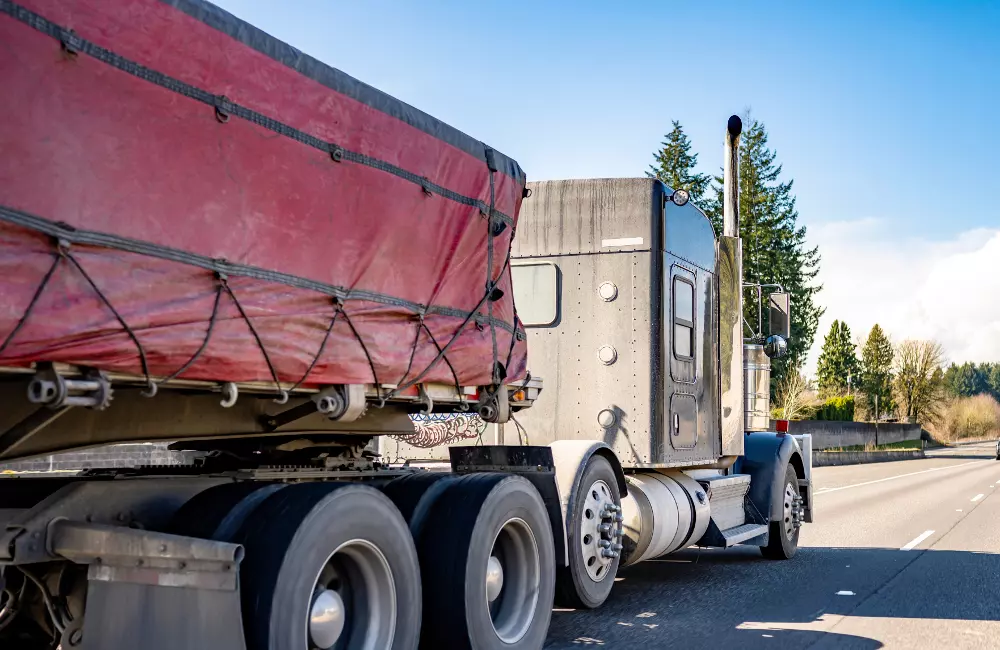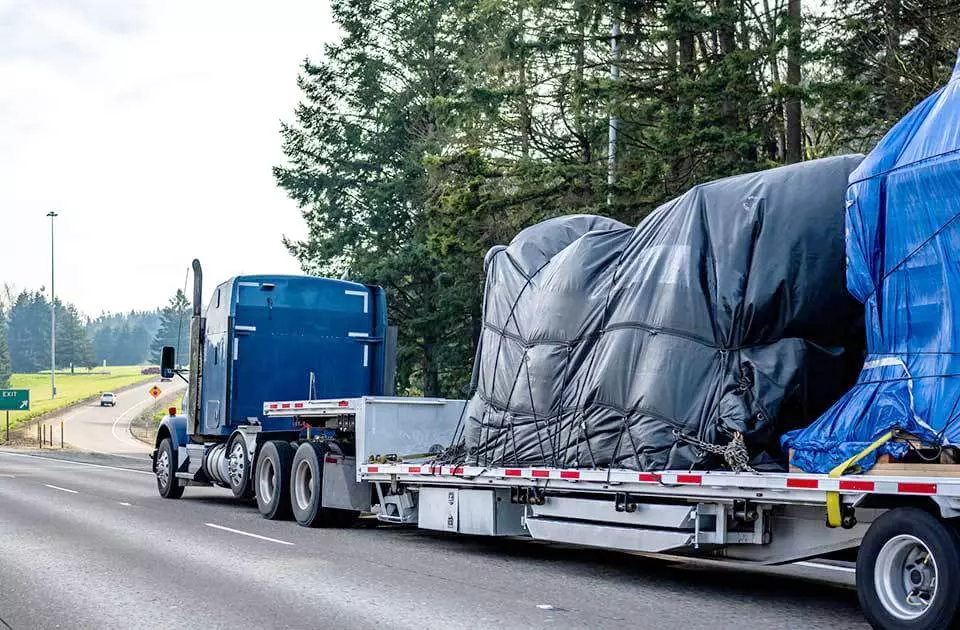Freight transportation can be a challenging operation, especially during inclement weather conditions. During storms, hail, and heatwaves, cargo becomes highly susceptible to weather damage especially when using flatbed or gondola trailers.
According to a recent publication, nearly 11% of cargo is damaged during transit. This number increases when using trailers that aren’t fully covered like dry vans. Therefore, many truckers use tarps as a viable solution, often at the request of shippers, to reduce the risk of cargo damage during transport.
Tarps are heavy-duty covers made of waterproof and puncture-resistant materials that enhance durability and protect cargo from adverse conditions. They’re generally made from vinyl, polyethylene, mesh, and other high-quality materials.
Although these covers reduce damage risk, tarping a trailer can be a tedious job. Therefore, in this article, we’ll teach you how to tarp a trailer using step-by-step instructions and also various reasons why you should do so.
We’ll also discuss the key challenges truckers face during the process and also share some best practices that many experienced truckers adopt.
What Is a Trailer Tarp?
A trailer tarp, also known as a truck tarp or trailer cover, is a large piece of material that is placed on trailers to protect cargo and enhance cargo stability during transportation.

Tarps are available in multiple materials, including vinyl, canvas, and nylon. They’re generally used by truckers that transport cargo on open-deck trailers such as flatbeds, lowboys, gondolas, and step-deck trailers.
Some truckers also use them as an additional security measure to protect cargo from theft and physical damage when parked or during temporary storage. Modern trailer tarps are available in various sizes and configurations to fit different types of trailers and sizes.
They can be tied onto each trailer using bungee cords, ratchet straps, and other securing devices. Below is a list of the most common trailer tarp materials used in the trucking industry.
Each has its benefits and drawbacks, so truckers consider several factors before choosing one, including cost, size, and resistance.
- Vinyl
- Canvas
- Polyethylene
- Mesh
- Nylon
How to Tarp a Trailer
Tarping a trailer requires more preparation work than the actual task itself. Below is a step-by-step guide to tarping a trailer. Make sure that you do this in a safe environment.
- Ensure You Have the Necessary Tools – Tarping a trailer might look like a quick and safe process, but there are certain hazards and complications you must proactively address and be prepared for. Start by getting all of the necessary tools and equipment like cords or straps, tie-downs, ladder, and other items. Use personal protective equipment (PPE) like gloves, safety boots, and overalls or long pants. Ensure you have the right tarp type and size and check for any signs of damage before starting the process.
- Prepare Your Trailer – Next, drive your truck onto a level and stable area to ensure trailer and cargo stability during the tarping process. Apply the brakes so the trailer remains stationary.
- Inspect Your Surroundings & Load – Another precautionary measure is to check for any obstacles or safety hazards around the trailer. Remember to check your cargo to ensure it’s secure and well organized. Loose cargo can damage the tarp and impact overall security during transport.
- Secure & Protect Loads – Although tarps provide additional stability, they shouldn’t be completely relied on to hold your cargo in place. Therefore, your first task would be to secure your cargo using the appropriate tie-downs before draping the tarp over. Many goods have sharp edges or corners. Use edge protectors, moving pads, or cardboard to prevent cuts or premature wear and tear on your tarp.
- Lay the Tarp Over the Cargo – Then, initiate the tarping process by unrolling the trailer tarp over the trailer length. Depending on your preference or trailer type, you can start unrolling from the front or back. Pay attention to the hook rings or strap positions and ensure the tarp is the right side up and centered from both sides.
- Tie Down the Tarp – Once you’ve covered the trailer with the tarp, tie down the four corners first to hold it in place. From there, you can secure the sides using bungee cords or straps. Take your time and work your way around the trailer to ensure all sides are secure.
- Double-Check Tarp & Tie-Downs – Your cargo should now be well covered with the tarp. However, for additional due diligence, examine your trailer and check for any loose spots or areas needing extra securing. You can also adjust the cargo if it’s loose to avoid shifting during transit. Once done, you’re ready to drive.
Why You Should Cover Your Cargo with a Tarp
Trailer tarping offers several benefits to truckers and shippers. They offer cargo protection and security, provide load stability, and more. Let’s take a closer look below.

Cargo Protection
Trailer tarps provide an additional security layer for flatbed and other open-deck trailers, allowing truckers to shield cargo from rain, snow, hail, debris, dust, and ultraviolet (UV) rays.
These elements can increase the risk of cargo damage and cause shippers and truckers unnecessary expenses. Tarping offers a quick and inexpensive solution to minimize damage risks.
Cargo Security
Along with protecting cargo from weather-related issues, tarps also reduce the risk of theft and vandalism when hauling cargo across vast distances, especially in remote locations or on unsafe routes.
Although tarps don’t guarantee theft protection, they make it more challenging for individuals to access the cargo. Additionally, they make the cargo less susceptible to tampering or pilferage.
Load Stability
Trailer tarps can help secure and stabilize cargo by holding it together when tied down. They’re incredibly useful for open-deck trailers, as they enhance road safety in the event that some cargo comes loose. They can also improve transport efficiency by allowing truckers to safely stack cargo higher than the sides of the trailer.
State Compliance
Most US states legally require truckers to use tarps to ensure road safety and prevent falling cargo or debris. Examples include Arkansas, Alaska, Arizona, Florida, New York, and Nevada.
Hence, another benefit of using them is to avoid heavy penalties and fines by the United States Department of Transportation’s Federal Motor Carrier Safety Administration (FMCSA) when hauling cargo in states where tarping is mandatory.
Challenges & Best Practices When Tarping Trailers
Below are the key challenges truckers face when tarping trailers and the best practices to address them.
Tarping in Favorable Weather Conditions
One of the biggest challenges truckers face is tarping a trailer in rain, snow, strong winds, and other inclement weather conditions. Rain makes tarps slippery, while the wind makes it challenging to hold them steady when securing them on a trailer.
How to Deal With It: The easiest way to avoid these issues is to wait for better weather conditions or tarp your trailer in a sheltered area. In many cases, waiting may not be an option, especially if your cargo is already loaded. You may have to temporarily park your trailer indoors or act quickly to minimize weather-related damage.
Securing Cargo
Flatbed and lowboy trailers are often used to transport irregularly shaped or oversized cargo, which can pose challenges for truckers looking to tarp their trailers. They are often required to pre-fit-check their tarps and make proactive adjustments to procure the right size. Additionally, they must protect their tarps from cargo with sharp edges and corners.
How to Deal With It: Tarps are available in different materials and sizes. Therefore, you can use large ones to cover the trailer and cargo appropriately. To prevent wear, tear, and cuts, you can use edge protectors or wrap your cargo.
Using Suitable Tarp Materials
Another challenge truckers face is deciding which tarp material to opt for, considering the various choices available in the market. Materials like vinyl are heavy and unwieldy, making them more difficult to work with. Polyethylene is incredibly lightweight, making it difficult to use in windy conditions.
Picking the Right Tarp Material: Every tarp material has its perks and drawbacks. To make the right choice, you simply need to learn about the different types and their applications or benefits. Vinyl Tarps - The most common tarp material in the industry. It's inexpensive, durable, and incredibly versatile in terms of protection. Canvas Tarps - These tarps are breathable and commonly used by truckers to cover and protect machinery, construction equipment, etc. Polyethylene Tarps - As mentioned above, polyethylene is lightweight, making it easier to use. Since it's waterproof, it's also the go-to choice for truckers hauling cargo in wet conditions. Mesh Tarps - A suitable tarp material to cover sand, gravel, and debris. They provide ventilation to protect the materials' structural integrity, especially in hot and humid conditions. Nylon Tarps - The ideal tarps for hot and sunny conditions. They're UV-resistant and provide adequate protection for heat and light-sensitive cargo.
Safely Tarping Trailers
Flatbed trailers can be loaded up to 13 feet 6 inches high. Moreover, the trailer itself is 4 to 5 feet from the ground. Hence, truckers hauling tall cargo may have to tarp trailers from around 20 feet off the ground, making the process dangerous.
Many truckers climb onto the trailer, while others use ladders or platforms to reach the top. In either case, they must minimize safety hazards and practice caution at all costs.
How to Deal With It: The best way to mitigate safety risks is by working with a team whenever possible to simplify the process and split the tasks. You should also wear safety equipment to prevent injuries and park your trailer in a safe location with the brakes applied. Avoid tarping in the rain or snow to minimize the risk of slip-and-fall accidents.
Time Management
Tarping a trailer takes time and resources. It can affect scheduling and lead to delays or productivity dips, especially when not done efficiently. Truckers often lose valuable time, affecting their Hours of Service (HOS) and accumulating high opportunity costs.
How to Deal With It: Ideally, you should proactively account for the additional lead time to efficiently fit the cargo handling and tarping process. When picking up cargo from a client's facility, you can ask shippers whether it is possible to start tarping during the loading process itself. Many truckers also leverage the sleeper berth split rule during the cargo handling process and use their shorter break periods to account for HOS losses.

Get Free Course Access
If you enjoyed the article, don’t miss out on our free supply chain courses that help you stay ahead in your industry.

Andrew Lin
Co-Founder & Writer
at freightcourse
About the Author
Andrew is a multi-business owner with over 12 years of experience in the fields of logistics, trucking, manufacturing, operations, training, and education.
Being the co-founder of freightcourse has given him the ability to pursue his desire to educate others on manufacturing and supply chain topics.
Follow us